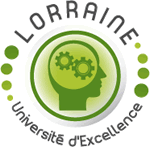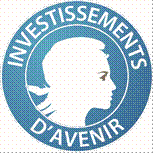Communication orale au congrès Printemps de la Cardiologie :
S-nitrosation decreases AT1 receptor mediated vasoconstriction and myogenic tone on rat middle cerebral arteries par M-L BOURESSAM, Doctorante
Communication orale au congrès Printemps de la Cardiologie :
S-nitrosation decreases AT1 receptor mediated vasoconstriction and myogenic tone on rat middle cerebral arteries par M-L BOURESSAM, Doctorante
Présentation orale lors de la Journée Scientifique de l'école doctorale BioSE du 28 mars 2018 :
Derivatization methods with liquid chromatography- HCD tandem mass spectrometry for the measurement of nitric oxide species coming from S-nitrosoglutathione par H. YU, Doctorante
L'article "Polymeric nanoparticles for increasing oral bioavailability of curcumin" vient de paraître dans le journal "Antioxidants", dans l'issue spéciale "Inspired by nature : Antioxidants and Nanotechnology".
Auteurs : Anita Umerska, Caroline Gaucher, Felipe Oyarzun-Ampuero, Isabelle Fries-Raeth, Florence Colin, Maria Gabriela Villamizar-Sarmiento, Philippe Maincent, Anne Sapin-Minet.
Référence de l'article : Antioxidants 2018, 7(4), 46; https://doi.org/10.3390/antiox7040046
Article accessible en cliquant ici.
Abstract :
Despite the promising biological and antioxidant properties of curcumin, its medical applications are limited due to poor solubility in water and low bioavailability. Polymeric nanoparticles (NPs) adapted to oral delivery may overcome these drawbacks. Properties such as particle size, zeta potential, morphology and encapsulation efficiency were assessed. Then, the possibility of storing these NPs in a solid-state form obtained by freeze-drying, in vitro curcumin dissolution and cytocompatibility towards intestinal cells were evaluated. Curcumin-loaded Eudragit® RLPO (ERL) NPs showed smaller particle diameters (245 ± 2 nm) and better redispersibility after freeze-drying than either poly(lactic-co-glycolic acid) (PLGA) or polycaprolactone (PCL) NPs. The former NPs showed lower curcumin encapsulation efficiency (62%) than either PLGA or PCL NPs (90% and 99%, respectively). Nevertheless, ERL NPs showed rapid curcumin release with 91 ± 5% released over 1 h. The three curcumin-loaded NPs proposed in this work were also compatible with intestinal cells. Overall, ERL NPs are the most promising vehicles for increasing the oral bioavailability of curcumin.
Offres de recrutements (un doctorat et un post-doctorat) financés par Lorraine Université d'Excellence (LUE) IMPACT Biomolecules. Date limite d'envoi de candidature : 30 avril 2018.
Pour plus de renseignements, contacter le Dr Caroline GAUCHER caroline.gaucher@univ-lorraine.fr


Lors de la 2ème réunion du COST Action NutRedOx qui se déroule du 15 au 16 février 2018 à Palma de Majorque en Espagne, Le Dr Caroline GAUCHER donnera une conférence sur le projet "Impact Biomolécules" financé par Lorraine Université d'Excellence (UL).


nanoCONTROL, une Start-up issue des travaux de l'EA 3452.
Les travaux de l'EA sur les nanoparticules d'or ont mené, avec le soutien de l'incubateur lorrain, à l'incubation d'une Start-up depuis le 05 décembre 2017.
Ce projet intitulé "nanoCONTROL" porte sur le contrôle et la synthèse de nanoparticules de très grande qualité "grade pharmaceutique".
L'article "Highly sensitive and simple liquid chromatography assay with ion-pairing extraction and visible detection for quantification of gold from nanoparticles" vient de paraître dans le journal "Talanta"
Auteurs : Pallotta A., Philippe V., Boudier A., Leroy P., Clarot I.
Référence de l'article : Talanta. 179 (2018) 307-311 Doi : 10.1016/j.talanta.2017.11.016
Abstract :
A simple isocratic HPLC method using visible detection was developed and validated for the quantification of gold in nanoparticles (AuNP). After a first step of oxidation of nanoparticles, an ion-pair between tetrachloroaurate anion and the cationic dye Rhodamine B was formed and extracted from the aqueous media with the help of an organic solvent. The corresponding Rhodamine B was finally quantified by reversed phase liquid chromatography using a Nucleosil C18 (150mm × 4.6mm, 3µm) column and with a mobile phase containing acetonitrile and 0.1% trifluoroacetic acid aqueous solution (25/75, V/V) at 1.0mLmin-1.and at a wavelength of 555nm. The method was validated using methodology described by the International Conference on Harmonization and was shown to be specific, precise (RSD < 11%), accurate and linear in the range of 0.1 - 30.0µM with a lower limit of quantification (LLOQ) of 0.1µM. This method was in a first time applied to AuNP quality control after their synthesis. In a second time, the absence of gold leakage (either as AuNP or gold salt form) from nanostructured multilayered polyelectrolyte films under shear stress was assessed.
A compter du 1er janvier 2018, Mme Ariane Boudier prend le relais de Mr Pierre Leroy à la direction de l'équipe EA3452 CITHEFOR.
Un article dans le magazine d'information de l'Université de Lorraine (Factuel) lui est consacré ici.
Mr Arnaud Pallotta, doctorant de l'équipe, soutiendra sa thèse de doctorat le 08 décembre 2017 à 10h00 en amphithéâtre Béné
Elle s'intitule "Films polymériques pour le développement de stents innovants"
Le jury est composé de :
- Mr Benoit Frisch (Rapporteur, DR, UMR 7199, CNRS, Université de Strasbourg, Strasbourg)
- Mme Reine Nehmé (Rapporteur, MCU, UMR 731, Université d’Orléans, Orléans)
- Mr Igor Clarot (Examinateur, PR, EA 3452, Université de Lorraine, Nancy directeur de thèse)
- Mme Ariane Boudier (Examinateur, MCU, EA 3452, Université de Lorraine, Nancy co-directrice de thèse)
- Mr Emmanuel Lamouroux (Membre invité, MCU, UMR 7565, Université de Lorraine, Nancy)
Mme Hui MING, doctorante de l'équipe, soutiendra sa thèse de doctorat le 07 Décembre 2017 à 14:00 en Salle de Thèse
Elle s'intitule "Développement de formulations polymériques de S-nitrosoglutathion comme traitement per os pour prévenir les maladies inflammatoires chroniques de l’intestin"
Le jury est composé de :
- Pr. Gilles Ponchel (Rapporteur, UMR 8612, CNRS, Université Paris-Sud, Paris)
- Pr. Aurélie Malzert-Fréon (Rapporteur, EA 4258, CNRS, Université de Caen Normandie, Caen)
- Dr. Anne Sapin-Minet (Examinateur, EA 3452, Université de Lorraine, Nancy, directeur de thèse)
- Dr. Franck Hansmannel (Examinateur, UMR 954, INSERM, Université de Lorraine, Nancy, co-directeur de thèse)
- Dr. David Moulin (Membre invité, UMR 7365, CNRS, Université de Lorraine, Nancy)